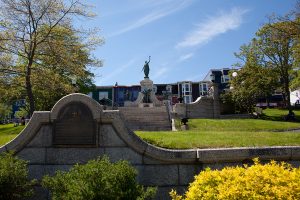A granite burial chamber that has become a tomb of the unknown soldier on July 1 was lowered into place at the Newfoundland National War Memorial in St. John’s in early April. On Saturday, May 25th the remains of a Royal Newfoundland Regiment soldier who died in northern France during the First World War was returned to Newfoundland and Labrador.

A lying-in-state took place at Confederation Building from June 28-30 to allow members of the public to pay their respects. On July 1, large crowds gathered in downtown St. John’s for the annual Memorial Day remembrance service and to mark the centennial anniversary of the Newfoundland National War Memorial. As part of the July 1 ceremony, meanwhile, the soldier’s remains were re-interred inside a newly constructed granite burial chamber at the base of the 100-year-old monument.
It is just the second such tomb in Canada, with the National War Memorial in Ottawa adding a tomb of the unknowns nearly a quarter-century ago. It’s essential that the identity of the soldier remains unknown because he will symbolically represent all Newfoundlanders and Labradorians from all branches of service who have no known grave.
Newfoundland was a self-governing British Dominion during the First World War, and more than 12,000 Newfoundlanders served in military or support services during the conflict. More than 1,700 lost their lives during the war, and some 800 of those who died have no known grave. Roughly 600 of those unknown graves are located in France and Belgium, according to the Commonwealth War Graves Commission, and are marked by headstones with the wording “Known Unto God.”
The monument is built of marble, with bronze statuary and iron fencing, and was the work of world-renowned British artists, Gilbert Bayes and Ferdinand Victor Blundstone. Bronze plaques representing each of the following adorn the Memorial:
- The War of 1812-15
- The First World War
- The Second World War
- The Korean War
- The Afghanistan War
It is the province’s largest and most substantial work of public art, combining allegorical and realistic figures to portray Newfoundland’s “First World War effort”. It overlooks St. John’s harbour, the departure point for many of those who served and died, and the location to which many veterans, including those physically and mentally scarred, returned.
La cámara funeraria de granito que se ha convertido en la tumba del soldado desconocido el 1 de julio fue bajada a su lugar en el Monumento Nacional a la Guerra de Terranova, en St. El sábado 25 de mayo fueron devueltos a Terranova y Labrador los restos de un soldado del Regimiento Real de Terranova que murió en el norte de Francia durante la Primera Guerra Mundial.
Del 28 al 30 de junio se celebró un velatorio en el edificio de la Confederación para que el público pudiera presentar sus respetos. El 1 de julio, una gran multitud se reunió en el centro de St. John’s para celebrar el servicio conmemorativo anual del Día de los Caídos y conmemorar el centenario del Monumento Nacional a los Caídos en la Guerra de Terranova. Como parte de la ceremonia del 1 de julio, los restos del soldado fueron inhumados de nuevo en una cámara funeraria de granito recién construida en la base del centenario monumento.
Se trata de la segunda tumba de este tipo en Canadá, ya que el National War Memorial de Ottawa añadió una tumba de los desconocidos hace casi un cuarto de siglo. Es esencial que la identidad del soldado siga siendo desconocida porque representará simbólicamente a todos los terranovenses y labradorenses de todas las ramas del servicio que no tienen tumba conocida.
Terranova fue un Dominio Británico autónomo durante la Primera Guerra Mundial, y más de 12.000 terranovas sirvieron en el ejército o en servicios de apoyo durante el conflicto. Más de 1.700 perdieron la vida durante la guerra, y unos 800 de los que murieron no tienen tumba conocida. Alrededor de 600 de esas tumbas desconocidas se encuentran en Francia y Bélgica, según la Comisión de Tumbas de Guerra de la Commonwealth, y están marcadas por lápidas con la inscripción “Known Unto God”.
El monumento está construido en mármol, con estatuas de bronce y vallas de hierro, y fue obra de los mundialmente conocidos artistas británicos Gilbert Bayes y Ferdinand Victor Blundstone. Adornan el monumento placas de bronce que representan cada uno de los siguientes acontecimientos
- La Guerra de 1812-15
- Primera Guerra Mundial
- Segunda Guerra Mundial
- La Guerra de Corea
- La Guerra de Afganistán
Se trata de la mayor y más importante obra de arte público de la provincia, que combina figuras alegóricas y realistas para retratar el “esfuerzo de la Primera Guerra Mundial” de Terranova. Domina el puerto de St. John’s, punto de partida de muchos de los que sirvieron y murieron, y lugar al que regresaron muchos veteranos, incluidos los que quedaron marcados física y mentalmente.


